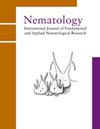Steinernema indicum n. sp., a new entomopathogenic nematode (Nematoda: Steinernematidae) from India
IF 1.2
4区 生物学
Q2 ZOOLOGY
引用次数: 2
Abstract
A new species of entomopathogenic nematode, Steinernema indicum n. sp., was isolated from a coconut palm (Cocos nucifera) field in the district of Udupi, Karnataka, India. The infective juveniles (IJ) of S. indicum n. sp. possess a body length of 1043 (869-1172) μm. The lateral fields are formed by eight equally spaced and developed ridges (nine incisures) in the mid-body region, giving the formula 3, 8, 7, 5. The excretory pore is located posterior to the mid-pharynx region (D% = 63), and the hyaline region occupies ca half of the tail length. The first-generation males are characterised by very short spicules 66 (60-70) μm long. The male spicules are moderately curved with a sharp tip and are golden-brown in colour with the manubrium elongate and with a length to width ratio of 1.92:1. There are 11 pairs of genital papillae plus a single midventral papilla located anterior to the cloacal region. The first-generation male of S. indicum n. sp. is characterised by the presence of a single dorsal postcloacal papilla, a typical diagnostic character that has not been reported from any other steinernematid species. The first-generation male tail has a short mucron present in ca 40% of specimens examined and a second-generation male tail showing a short mucron present in ca 65% of male specimens examined. The first and second-generation females possess a slightly protruding post-anal swelling. The new species is further characterised by sequences of the internal transcribed spacer (ITS) and partial 28S regions (D2-D3) of the ribosomal DNA (rDNA). Phylogenetic analyses confirm that S. indicum n. sp. belongs to the glaseri-group and, based on both ITS and D2D3 genes, showed that S. indicum n. sp. is a member of the karii clade.印度一种新的昆虫病原线虫(线虫目:印度线虫科)
从印度卡纳塔克邦乌杜皮地区的椰子田中分离到一种新的昆虫病原线虫Steinerma indicum n.sp。印度S.indicum n.sp.的感染性幼体(IJ)体长为1043(869-1172)μm。侧场由身体中部区域的八个等距且发育的脊(九个切口)形成,给出公式3、8、7、5。排泄孔位于咽部中部(D%=63)的后部,透明区约占尾部长度的一半。第一代雄性的特征是非常短的针状物66(60-70)μm长。雄性骨针适度弯曲,尖端锋利,呈金棕色,柄部细长,长宽比为1.92:1。有11对生殖乳头加上一个位于泄殖腔区域前方的中腹乳头。印度S.indicum n.sp.的第一代雄性的特征是存在单个背侧颈后乳头,这是一个典型的诊断特征,在任何其他斯坦纳线虫类物种中都没有报道过。第一代雄性尾巴的短粘液质存在于约40%的受检标本中,第二代雄性尾巴显示短粘液质出现于约65%的受检雄性标本中。第一代和第二代雌性肛门后肿胀轻微突出。该新物种的进一步特征是内部转录间隔区(ITS)和核糖体DNA(rDNA)的部分28S区(D2-D3)的序列。系统发育分析证实印度S.indicum n.sp.属于glaseri类群,并且基于ITS和D2D3基因,表明印度S.indicus n.sp..是卡里亚支的一员。
本文章由计算机程序翻译,如有差异,请以英文原文为准。
求助全文
约1分钟内获得全文
求助全文
来源期刊

Nematology
生物-动物学
CiteScore
2.60
自引率
33.30%
发文量
67
审稿时长
3 months
期刊介绍:
Nematology is an international journal for the publication of all aspects of nematological research (with the exception of vertebrate parasitology), from molecular biology to field studies. Papers on nematode parasites of arthropods, and on soil free-living nematodes, and on interactions of these and other organisms, are particularly welcome. Research on fresh water and marine nematodes is also considered when the observations are of more general interest.
Nematology publishes full research papers, short communications, Forum articles (which permit an author to express a view on current or fundamental subjects), perspectives on nematology, and reviews of books and other media.
 求助内容:
求助内容: 应助结果提醒方式:
应助结果提醒方式:


